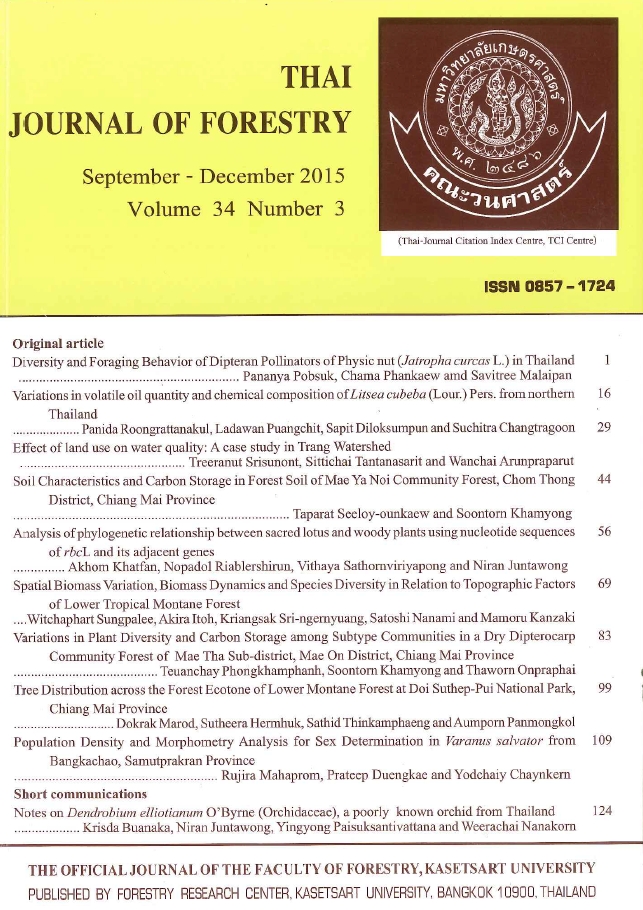Population Density and Morphometry Analysis for Sex Determination in Varanus salvator from Bangkachao, Samutprakran Province
Main Article Content
บทคัดย่อ
The study investigated the population density and morphometie analysis for sex determination of the water monitor (Varanus salvator) in Bagkachao, Prapadaeng, Samutprakran province, using mark capture-recapture during January 2012 to December 2012. Twenty six live-traps were placed every month resulting (286 trap-days in total) and each reptile was tagged with a passive integrated transponder (PIT tag). Forty one lizards were recaptured (15.86% trap success). The population size was estimated using the Mark program software at 84 ± 50 individuals (min 47, max 306). The population density was 25.85 ± 15.38 lizards per square kilometer (0.258 ± 0.153 lizards ha-1). Analysis of the captured specimens indicated an external sex difference in the eye-to-ear length (EEaL) (P < 0.05), with a mean (±SE) of 31.32 ± 1.19 in females and 35.36±1.29 in males. No juveniles were captured. The captured population structure ratios for sub-adult:adult consisted of 1:4.8, with a 1:1.6 sex ratio, and a 1:1.5 sub-adult sex ratio and 1: 1.12 adult sex ratio. The results indicated that V. salvator has not reached population saturation due to the reptile’s habit of moving from one place to forage. This behavior allows several individuals to share the same space during the same period, depending on the integrity of the area and the habitats used by different-aged individuals. Moreover, mortality from various causes in the area revealed a declining population. Consequently, a proper policy is needed for the conservation of this reptile in the study area.
Keywords: Passive integrated transponder, population density, morphometry, Varanus salvator
Downloads
Article Details

อนุญาตภายใต้เงื่อนไข Creative Commons Attribution-NonCommercial-NoDerivatives 4.0 International License.
ข้าพเจ้าและผู้เขียนร่วม (ถ้ามี) ขอรับรองว่า ต้นฉบับที่เสนอมานี้ยังไม่เคยได้รับการตีพิมพ์และไม่ได้อยู่ในระหว่างกระบวนการพิจารณาตีพิมพ์ลงในวารสารหรือสิ่งตีพิมพ์อื่นใด ข้าพเจ้าและผู้เขียนร่วม (ถ้ามี) ยอมรับหลักเกณฑ์และเงื่อนไขการพิจารณาต้นฉบับ ทั้งยินยอมให้กองบรรณาธิการมีสิทธิ์พิจารณาและตรวจแก้ต้นฉบับได้ตามที่เห็นสมควร พร้อมนี้ขอมอบลิขสิทธิ์ผลงานที่ได้รับการตีพิมพ์ให้แก่วารสารวนศาสตร์ คณะวนศาสตร์ มหาวิทยาลัยเกษตรศาสตร์ กรณีมีการฟ้องร้องเรื่องการละเมิดลิขสิทธิ์เกี่ยวกับภาพ กราฟ ข้อความส่วนใดส่วนหนึ่ง หรือ ข้อคิดเห็นที่ปรากฏในผลงาน ให้เป็นความรับผิดชอบของข้าพเจ้าและผู้เขียนร่วม (ถ้ามี) แต่เพียงฝ่ายเดียว และหากข้าพเจ้าและผู้เขียนร่วม (ถ้ามี) ประสงค์ถอนบทความในระหว่างกระบวนการพิจารณาของทางวารสาร ข้าพเจ้าและผู้เขียนร่วม (ถ้ามี) ยินดีรับผิดชอบค่าใช้จ่ายทั้งหมดที่เกิดขึ้นในกระบวนการพิจารณาบทความนั้น”


